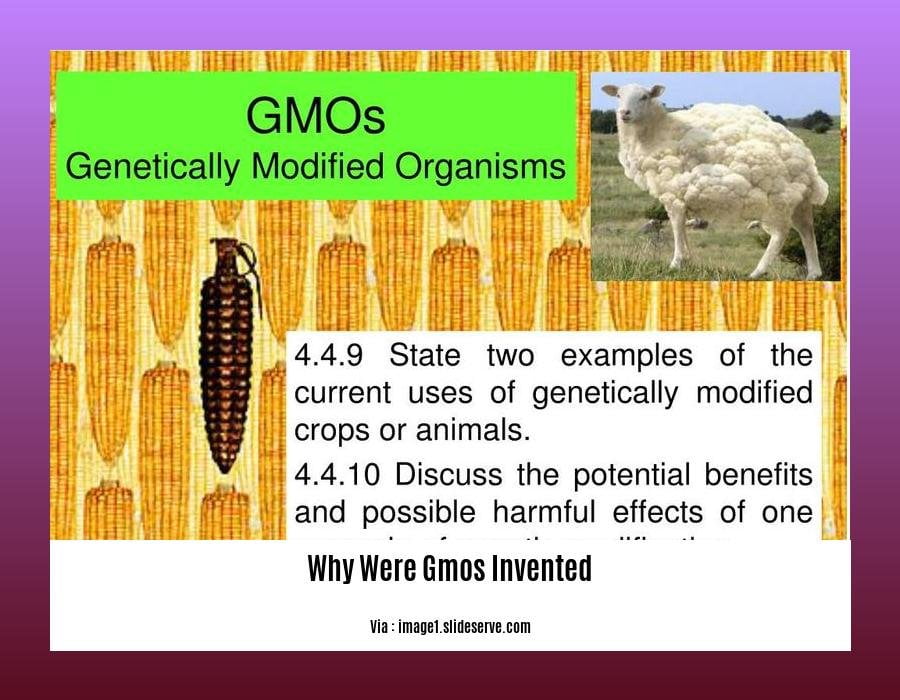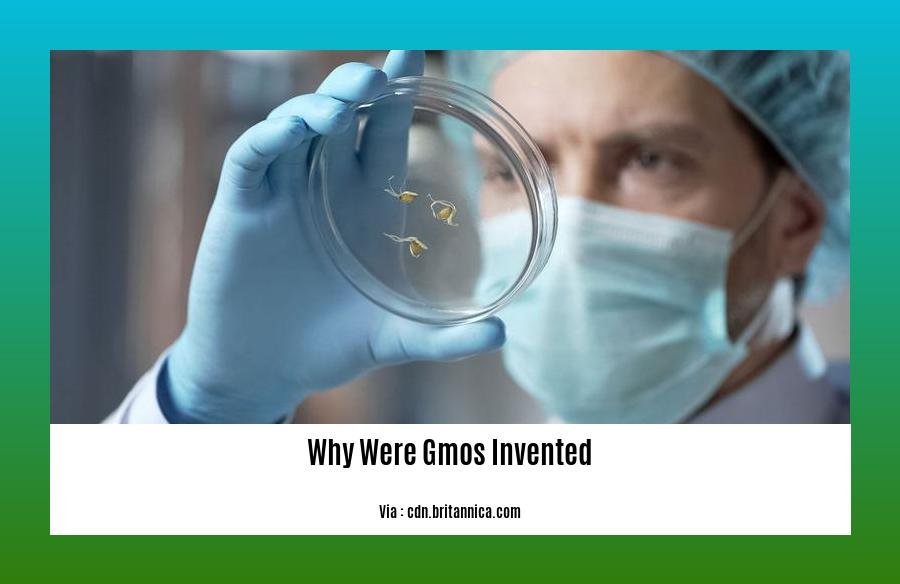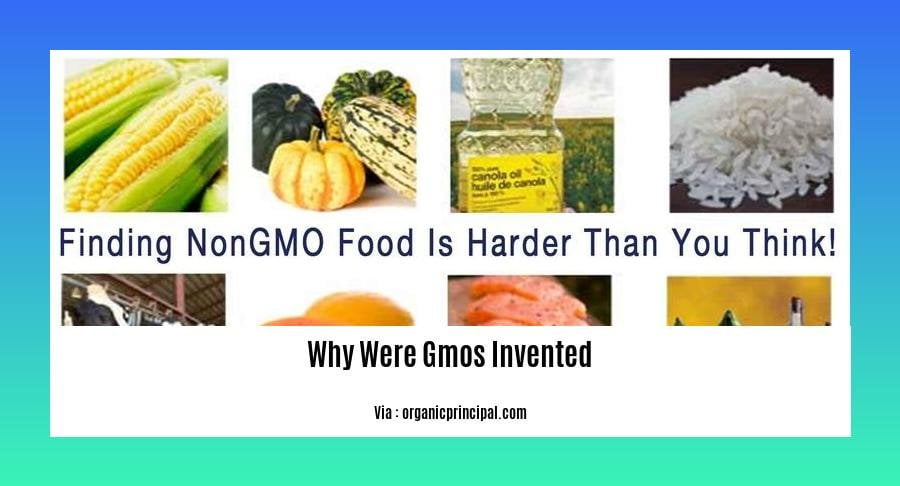In the realm of modern agriculture, the invention of genetically modified organisms (GMOs) stands as a transformative milestone. Uncover the compelling reasons behind the creation of GMOs in our comprehensive exploration titled “Why Were GMOs Invented: Unraveling the History and Impact of Genetically Modified Organisms”. Delve into the intriguing world of genetic engineering as we examine its profound implications for agriculture, health, and the environment, shedding light on the scientific advancements and societal debates surrounding these remarkable innovations.
Key Takeaways:
GMO crops were invented to address issues like preventing crop and food loss, controlling weeds, producing animals for research, providing safer herbicides, and creating healthier oils.
The most common GMO crops help farmers prevent crop and food loss and control weeds.
Some GMOs benefit consumers, like the creation of a healthier oil from soybeans.
GMO crops were developed to resist specific pests and use low-cost, eco-friendly herbicides.
The safety of GMOs is a topic of debate, with some people believing the transfer of genes from bacteria to plants is unnatural.
Why Were GMOs Invented?

We live in a world where food production faces immense challenges:
- The demand for food continues to rise due to population growth.
- Agricultural land is finite, and climate change compounds the issue.
- Pests and diseases pose a constant threat to crops, leading to food loss and economic hardship for farmers.
It’s within this context that we see the emergence of genetically modified organisms (GMOs). Through genetic engineering, scientists can modify plants and animals to possess desirable traits.
So, why were GMOs invented?
1. To Increase Crop Yield:
A primary reason for the invention of GMOs was to increase crop yield, thereby addressing global food security. For example, scientists have engineered rice varieties resistant to pests and diseases, resulting in higher yields and reduced crop loss.
2. To Enhance Pest Resistance:
GMOs were also developed to protect crops from destructive pests. By genetically modifying crops to produce natural pesticides, farmers can minimize the use of harmful chemical pesticides. This not only reduces environmental pollution but also safeguards the health of farmworkers and consumers.
3. To Improve Nutritional Content:
Through genetic engineering, scientists can enhance the nutritional content of crops. A prime example is Golden Rice, a GMO variety of rice fortified with beta-carotene, a precursor of vitamin A. This rice aims to combat vitamin A deficiency, a major cause of blindness and childhood mortality in developing countries.
4. To Develop Herbicide-Resistant Crops:
Weeds compete with crops for water, nutrients, and sunlight, leading to reduced yields. GMO crops engineered to resist specific herbicides allow farmers to use these herbicides to control weeds without harming the crops, thereby improving productivity.
5. To Aid Medical Research:
GMOs have also found applications in medical research. For example, scientists have created transgenic mice with specific genetic modifications to study human diseases and develop treatments.
6. To Create Biofuels:
Genetically modified organisms are being explored as a source of biofuels. Scientists are engineering microorganisms and plants to produce oils that can be converted into renewable fuels, reducing our dependence on fossil fuels.
7. For Industrial Applications:
GMOs have industrial applications as well. For instance, genetically modified bacteria are used to produce bioplastics, offering a sustainable alternative to traditional plastics derived from petroleum.
Despite their potential benefits, GMOs remain controversial, with concerns regarding their impact on human health and the environment. Nevertheless, the invention of GMOs represents a significant advancement in agricultural technology, offering a potential solution to some of the world’s most pressing challenges in food production.
Unravel the intricate history of GMOs, tracing their evolutionary journey from inception to widespread application, and gain insights into the factors that fueled their development.
Dive into The History Of GMOs, a captivating narrative that unveils the origins of genetically modified organisms, charting their rise from the laboratory to the dinner table.
Explore the intriguing story behind Why Were GMO Foods Created, uncovering the compelling reasons that motivated scientists to embark on the path of genetic engineering in food production.
Embark on a quest to discover What Was The First GMO, unearthing the groundbreaking experiment that marked the advent of genetically modified organisms and forever changed the course of agricultural science.
Discover When Were GMO Foods First Introduced, tracing the timeline of GMOs’ introduction into the global food supply, and explore the events and factors that shaped their initial adoption and subsequent proliferation.
Enhancing Nutritional Content to Combat Malnutrition

We often hear about GMOs and their potential impact on our health and the environment, but do you know why they were invented in the first place? Join me as we embark on a journey to understand the reasons behind their creation.
Imagine living in a world where nutrient-rich foods are readily available to everyone. Malnutrition would be a thing of the past, and people would lead healthier lives. This is precisely the vision that drove scientists to develop genetically modified organisms (GMOs).
Addressing Nutrient Deficiencies
GMOs were invented to tackle the widespread issue of nutrient deficiencies. Traditional crops often lack essential nutrients like iron, zinc, and vitamin A. By genetically engineering crops, scientists can enhance their nutritional content to provide these vital nutrients that are often lacking in staple foods.
Fighting Hidden Hunger:
Hidden hunger occurs when people consume enough calories but still lack essential nutrients. This can lead to various health problems, including stunted growth, weak immune systems, and cognitive impairment. GMOs offer a promising solution to this hidden menace by delivering a nutrient-rich punch to staple crops, ensuring that people get the nourishment they need to thrive.
Improving Food Security
One of the primary reasons for the invention of GMOs was to increase food production and ensure food security. With the growing global population and the increasing demand for food, GMOs provide a way to maximize crop yields, reduce food waste, and make food more accessible to everyone.
Key Takeaways:
- GMOs were invented to address nutrient deficiencies by enhancing the nutritional content of staple crops.
- Combatting hidden hunger is a crucial goal of GMOs, aiming to provide essential nutrients that may be lacking in traditional diets.
- GMOs play a vital role in improving food security by increasing crop yields, reducing food waste, and making food more accessible.
Relevant URL Sources:
- Improving Nutrition through Biofortification–A Systematic Review
- Genetically Modified Plants: Nutritious, Sustainable, yet Underrated
Adapting crops to challenging environmental conditions
You’ve heard of genetically modified crops (GMOs), but do you know why they were invented? Let’s delve into the history, unravel the reasons, and explore their impact on agriculture, health, and the environment.
Key Takeaways:
- GMOs were invented to address challenges in food production and global food security.
- By adapting crops to challenging environmental conditions, GMOs can help increase crop yields and reduce the use of pesticides and herbicides, making agriculture more sustainable.
- GMOs have the potential to improve nutritional content, reduce the risk of foodborne illness, and aid in medical research.
- Concerns about GMOs mainly revolve around their potential impact on human health and the environment.
The Invention of GMOs: A Response to Global Challenges
The invention of GMOs was driven by a number of factors, including the need to:
Increase Crop Yields: GMOs can be engineered to be resistant to pests and diseases, tolerant to environmental stresses such as drought and salinity, and have higher yields, leading to increased food production.
Reduce the Use of Pesticides and Herbicides: By engineering crops to resist pests and weeds, GMOs can reduce the need for chemical pesticides and herbicides, protecting the environment and the health of farmworkers.
Improve Nutritional Content: GMOs can be modified to have higher levels of essential nutrients, such as vitamins and minerals, addressing malnutrition and deficiencies in staple crops.
Aid in Medical Research: GMOs are used in medical research to study human diseases and develop treatments, providing valuable insights and potential cures.
Addressing Concerns about GMOs
Despite their potential benefits, the invention of GMOs has been met with controversy and concerns about their safety and impact on human health and the environment.
Safety Concerns: Some people worry that GMOs may have unintended consequences for human health, such as allergies or long-term health effects. However, extensive research and regulatory approvals worldwide have deemed GMOs safe for consumption.
Environmental Concerns: Others are concerned about the potential impact of GMOs on biodiversity and ecosystems. Critics argue that GMOs may harm beneficial insects, promote the development of resistant pests, and lead to the loss of genetic diversity in natural plant populations.
The debate surrounding GMOs is complex and ongoing. As the science continues to evolve, it is crucial to base discussions and decisions on sound scientific evidence and transparent regulatory processes.
Relevant URL Sources:
- Science and History of GMOs and Other Food Modification P…
- Genetically Modified Plants: Nutritious, Sustainable, yet Underrated
Improving processing and storage traits for enhanced food quality
Concerns about food loss and waste continue to grow due to poor processing and storage conditions, leading to reduced food quality and increased rates of spoilage. To address this pressing issue, scientists and researchers have turned to genetic modification as a means to enhance the processing and storage traits of crops, resulting in extended shelf life, improved nutritional value, and reduced food waste.
Genetic Modifications for Enhanced Food Quality
Genetic engineering techniques offer a precise and targeted approach to modifying the genetic makeup of crops, enabling scientists to introduce specific traits that improve their processing and storage characteristics. These modifications can range from altering the composition of cell walls to introducing genes that enhance the production of natural preservatives.
1. Enhanced Shelf Life:
– By manipulating genes responsible for fruit ripening, scientists can delay the softening process, reducing spoilage and extending the shelf life of fruits and vegetables.
– Genetic modifications can also increase the production of natural antioxidants, which help to slow down the deterioration of produce.
2. Improved Nutritional Content:
– Genetic modifications can enhance the nutritional value of crops by increasing the levels of essential vitamins, minerals, and other beneficial compounds.
– These biofortified crops can provide a more nutritious and balanced diet, addressing nutrient deficiencies in populations with limited access to diverse food sources.
3. Reduced Food Waste:
– By developing crops resistant to pests and diseases, genetic modifications can minimize crop losses during cultivation and storage.
– Enhanced tolerance to environmental stresses, such as drought and extreme temperatures, can further reduce yield losses and ensure a stable food supply.
4. Improved Processing Efficiency:
– Genetic modifications can optimize the composition and structure of crops to enhance their suitability for processing.
– This can lead to increased yields, reduced processing costs, and improved product quality.
Key Takeaways:
- Genetic modifications can enhance the processing and storage traits of crops, leading to extended shelf life, improved nutritional value, and reduced food waste.
- Techniques such as altering cell wall composition and introducing genes for natural preservatives can help maintain food quality and reduce spoilage.
- Biofortified crops with increased levels of essential nutrients can address nutrient deficiencies and provide a more nutritious diet.
- Enhanced resistance to pests, diseases, and environmental stresses can minimize crop losses and ensure a stable food supply.
- Genetic modifications can also optimize crop composition and structure for improved processing efficiency, increasing yields, and reducing costs.
Relevant URL Sources:
- Genetic Engineering for Enhanced Food Quality and Crop Protection
- Improving Food Quality and Safety With Genetic Engineering
FAQ
Q1: What are the key reasons behind the invention of GMOs?
A1: GMOs were invented to address various challenges, including preventing crop and food loss, controlling weeds, developing pest-resistant crops, producing animals for research, providing safer herbicides, making food more affordable and accessible, and creating healthier oils.
Q2: Why were GMO crops developed specifically for farmers?
A2: GMO crops were developed to aid farmers in preventing crop and food loss and controlling weeds, enabling them to increase crop yields and improve productivity.
Q3: Are there any GMO crops developed for consumer benefit?
A3: Yes, some GMO crops were developed specifically for consumer benefit. For example, soybeans have been genetically modified to produce a healthier oil with lower saturated fat content.
Q4: Why were crops developed with resistance to pests and low-cost herbicides?
A4: GMO crops with resistance to pests and low-cost herbicides were developed to reduce the need for pesticides and herbicides, making farming practices more environmentally friendly and cost-effective.
Q5: What is the controversy surrounding the invention of GMOs?
A5: The issue of GMO safety is controversial, with some individuals viewing the transfer of genes from bacteria to plants as an unnatural process. However, extensive research and safety assessments have been conducted to ensure the safety of GMOs for human consumption and the environment.
- China II Review: Delicious Food & Speedy Service - April 17, 2025
- Understand Virginia’s Flag: History & Debate - April 17, 2025
- Explore Long Island’s Map: Unique Regions & Insights - April 17, 2025
















